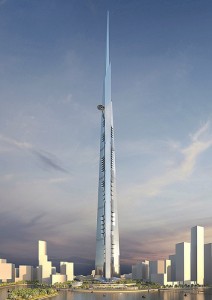Infographic: The world's tallest buildings by 2020


The Council on Tall Buildings and Urban Habitat (CTBUH) has released a study on the world's 20 tallest buildings projected to be built by 2020. The Council introduced the term 'megatall' to describe buildings over 600 meters (1,968 feet) tall, which is twice the height of the previous superlative 'supertall' buildings. Buildings that have been stalled and do not have a predictable completion date have been excluded from the study.
The 20 tallest megatall buildings, nicely lined up in the CTBUH's infographic below, are:
1. Kingdom Tower, Jeddah: 1,000+ meters (3,280+ feet)
2. Burj Khalifa, Dubai: 828 meters (2,717 feet)
3. Ping An Finance Center, Shenzen: 660 meters (2,165 feet)
4. Seoul Light DMC Tower: 640 meters (2,101 feet)
5. Signature Tower, Jakarta: 638 meters (2,093 feet)
6. Shanghai Tower, Shanghai: 632 meters (2,073 feet)
7. Wuhan Greenland Center, Wuhan: 606 meters (1,988 feet)
8. Makkah Royal Clock Tower Hotel, Makkah: 601 meters (1,972 feet)
9. Goldin Finance 117, Tian Jin: 597 meters (1,957 feet)
10. Lotte World Tower, Seoul: 555 meters (1,819 feet)
11. Doha Convention Center and Tower, Doha: 551 meters (1,808 feet)
12. One World Trade Center, New York City: 541 meters (1,776 feet)
13. Chow Tai Fook Guangzhou, Guangzhou: 530 meters (1,739 feet)
14. Tianjin Chow Tai Fook Binhai Center, Tian Jin: 530 meters (1,739 feet)
15. Dalian Greenland Center, Dalian: 518 meters (1,699 feet)
16. Pentominium, Dubai: 516 meters (1,693 feet)
17. Busan Lotte Town Tower, Busan: 510 meters (1,674 feet)
18. Taipei 101, Taipei: 508 meters (1,667 feet)
19. Kaisa Feng Long Centre, Kaisa: 500 meters (1,640 feet)
20. Shanghai WFC, Shanghai: 492 meters (1,614 feet)

Interesting but not surprising to see that half of the projects are in China and that 70 percent of the buildings are in Asian countries that are low in available area and high in population density.
Even more interesting would be to see where the highest occupiable/usable floors land in the buildings.
As the study points out:
With every increase in height, there are energy implications in the construction, maintenance, and occupation of a building. Additionally, with added height comes less space efficiency, as structural members and service cores increase to service the increased height of the building. At what point are the significant benefits of increased density provided by building tall overtaken by the energy repercussions of height?
Image: copyright CTBUH
This post was originally published on Smartplanet.com


